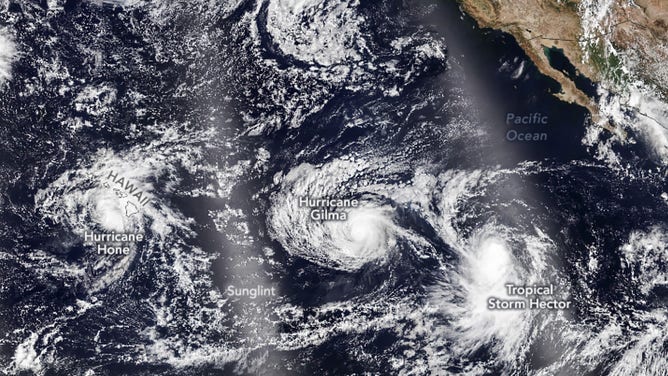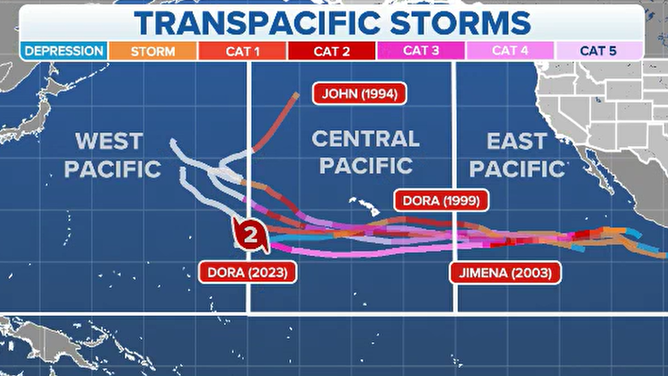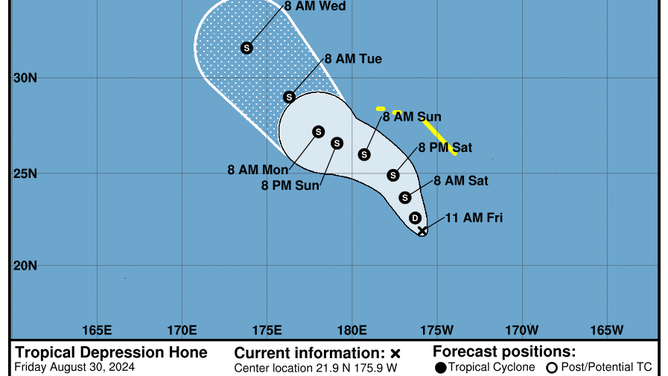Can a hurricane turn into a typhoon? Hone might achieve the rare feat
In 2023, Hurricane Dora made headlines for crossing the entire Pacific Ocean – a rare feat for any cyclone. The cyclone was one of many ingredients that helped produced a significant pressure gradient and wind-driven wildfires across Hawaii. At least 102 people were killed and more than $5 billion in damage done in the Aloha State.
Hawaii cleaning up as Hone moves away from islands
Hone continues to weaken and was downgraded to a tropical storm Monday after it blasted Hawaii's Big Island as a Category 1 hurricane with flooding rain, damaging winds and dangerous waves over the weekend.
HONOLULU – A cyclone more than 1,000 miles west of Hawaii will cross the international date line over the Labor Day weekend, marking its entry into what is known as the Northwest Pacific - a journey that few systems complete during their lifecycle.
Tropical Storm Hone originally developed several hundred miles southeast of the Hawaiian Islands in the central Pacific and passed south of the Big Island on Aug. 25.
The cyclone strengthened into a Category 1 hurricane while more than 50 miles south of the island chain, producing life-threatening surf and localized flash flooding.
A change in basins means the cyclone will be monitored by different agencies, such as the Joint Typhoon Warning Center (JTWC) and the Japan Meteorological Agency (JMA), which track tropical developments in the western Pacific.
The terms "tropical depression" and "tropical storm" remain the same, but once a system's sustained winds reach at least 74 mph, it is classified as a typhoon instead of a hurricane.

Tracking tropical cyclone activity in the eastern and central Pacific
(NOAA)
HURRICANE NAMES DORA, OTIS RETIRED FROM PACIFIC LIST AFTER DEADLY WRATH
The last cyclone to cross the dateline was Hurricane Dora in August 2023. The cyclone developed in the eastern Pacific and traveled through the central and into the western Pacific, a journey of more than 4,000 miles.
Fortunately, due to the vast expanse of the world's largest ocean, few areas were directly impacted by the former Category 4 cyclone.
However, Dora was one of the factors contributing to a significant pressure gradient and wind-driven wildfires across Hawaii. The impacts resulted in at least 102 fatalities and over $5 billion in damage in the Aloha State.
According to a NOAA database, only a handful of cyclones have completed the trek from the eastern and central regions to wind up in the western Pacific.
Besides Dora, other cyclones to complete the transition across all three basins include: Jimena (2003); Dora (1999); John (1994); Enrique (1991); and Georgette (1986).

Tropical cyclones that started in the eastern Pacific and made it into the western Pacific.
(FOX Weather)
CAN TROPICAL CYCLONES MAKE IT ACROSS THE ENTIRE PACIFIC OCEAN?
Atolls such as Kure, Midway and the Papahānaumokuākea Marine National Monument sit about 800 to 1,500 miles northwest of Hawaii and are the only landmasses close to the potential path of Hone.
None of the atolls are reported to have permanent residents and are used for conservation efforts in the world’s largest ocean.
Due to the system’s proximity, Tropical Storm Watches have been issued for the islands, which could be upgraded to warnings if future conditions warrant.
The areas sit just east of the international date line and are, therefore, under the jurisdiction of the Central Pacific Hurricane Center, based in Honolulu.
When west of 180 degrees east longitude, Hone is expected to restrengthen and approach typhoon status next week.

Track of Hone
Outside of the atolls, no landmasses will be threatened by the cyclone, as troughs exiting northeastern Asia will serve as a barrier and protect countries such as Japan, China, South Korea, North Korea and Russia from a threat from the southeast.
The cyclone is expected to eventually reach the cool waters of the far northern Pacific before increasing moisture around the Bering Sea and Alaska.
